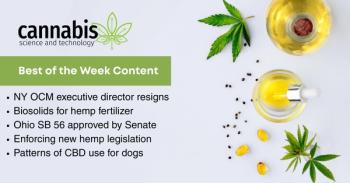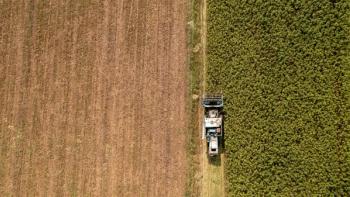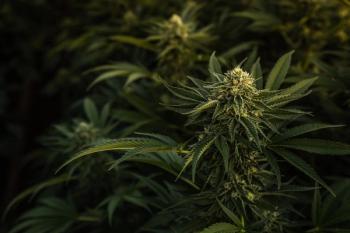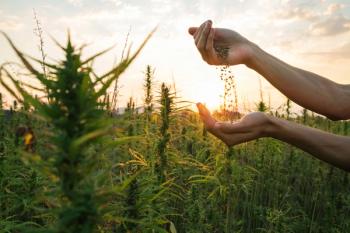
Cannabis Science and Technology
- November/December 2021
- Volume 4
- Issue 9
Differentiation of Group III Cannabis Cultivars into Novel Sub-Classes
The data presented here document the phytochemical composition of a large dataset of Group III cannabis cultivars and allow for the identification of distinct sub-classes.
The chemical characterization of different Cannabis sativa spp. cultivars has important regulatory and potential pharmacodynamic implications. While Groups I-III cultivars are distinguishable on the basis of total tetrahydrocannabinol concentrations and the relative ratio to cannabidiol, the expression of other secondary metabolites, such as the terpene family of phytoconstituents, has a more significant bearing on the potential therapeutic outcomes for medicinal end users as a result of the synergies associated with the “entourage effect.” In the work presented here, 131 Group III cannabis cultivars were analyzed for cannabinoid and terpene composition. Principal component and hierarchical cluster analyses were used to assess multidimensional relationships in the overall phytochemical content. Weak correlations were found between individual cannabinoid and terpene species; however, the relative expression of monoterpenoids and terpenoids were the most discriminative variables in terms of differentiation of individual cultivars into two distinct subclasses. The identification of distinct sub-classes within Group III cannabis on the basis of cis-2- pinanol, fenchol, and alpha-terpineol expression, suggests that these classifications can be used to guide more targeted therapeutic outcomes.
With the passage of the 1970 Controlled Substances Act, research into the medicinal properties and phytochemical constituents of cannabis was brought to a halt in the United States. As various states have legalized the use of cannabis within their borders, nascent research is being conducted, but remains fraught with legal peril, as cannabis is still prohibited at the Federal level. The study of cannabidiol (CBD)-rich hemp, now legal to grow in the United States as a result of the 2018 Farm Bill, is not hampered by these restrictions and research on the chemical composition and phytochemical diversity of commercially available cannabis can be performed.
From a regulatory perspective, cannabis is a Schedule 1 controlled substance that differs from hemp on the basis of total ∆9-tetrahydrocannbinol (∆9-THC) concentration, with the bifurcation occurring at 0.3% weight/ weight (w/w) total THC. This particular metric is the sum of the amount ∆9-THC plus the amount of its acidic precursor, tetrahydrocannabinolic acid (THCA), after accounting for the loss of mass during decarboxylation (that is, total THC = ∆9-THC + 0.877*THCA). However, and more specifically, cannabis cultivars can be classified into one of three groupings. Group I cannabis cultivars are THC-dominant strains (>20:1 THC/CBD); Group II cannabis cultivars have approximately equal amounts of THC and CBD (that is, ~1:1 THC/ CBD); and Group III cannabis (hemp) cultivars are CBD-dominant (that is, >20:1 CBD/THC). Remarkably, Groups I-III cannabis cultivars generally demonstrate indistinguishable morphological structures, with comparable flavonoid, terpene, and ancillary cannabinoid profiles (1). This lack of discernable phytochemotaxonomy is likely the result of extensive interbreeding and hybridization (2). However, minute differences in phytochemical composition may produce or affect different therapeutic outcomes for patients using medicinal cannabis.
Terpene molecules are ubiquitous hydrocarbons that are naturally abundant in cannabis or hemp and can stimulate a wide array of physiological responses (3). There are currently 20,000+ known quantifiable terpenes, with cannabis producing more than 120 different terpenes species (4). Most terpenes exhibit antimicrobial and anti-inflammatory properties, but other terpenes have been found to modulate blood glucose and attenuate pain (3). Additionally, terpenes such as beta-myrcene, myrcene, and limonene are all perceived as invigorating; whereas linalool, also found in lavender, is perceived to induce a sedative effect. Other terpenes, such as alpha- and beta-pinene produce bronchodilatory effects (5).
In this work, targeted cannabinoid and terpene analyses, in combination with multivariate statistical analysis, were used to identify and select hemp cultivars that produced increased amounts of cannabidiolic acid (CBDA). Using gas chromatography–mass spectrometry (GC–MS), two distinct clusters within Group III cannabis were identified on the basis of their cannabinoid and terpene expression profiles. A parallel analysis by high performance liquid chromatography (HPLC) also resulted in the separation of unique phytochemical clusters, albeit with less discrimination than was afforded by the GC–MS analysis. These results suggest that separate sub-classes within Group III cannabis can be identified on the basis of ancillary phytochemical expression; the elucidation of these discriminatory and bioactive features can possibly be used to guide medicinal end users towards pharmacodynamically more favorable treatment outcomes.
Material and Methods
Group III Cannabis Genetics
In this study, 131 novel Group III cannabis (hemp) cultivars created by ZED Therapeutics were included. These cultivars were selected on the basis of CBDA expression and the absence of discernible genetic abnormalities or poor performance characteristics. These included hermaphrodism, variegation, extremely long flowering periods, elongated internodal spacing, poor cannabinoid production, and susceptibility to insects, molds, and plant viruses. All plants were grown indoors in an organic blended soil medium (compost, worm casting, perlite, and cocoa coir) under ceramic metal halide (CMH) and high-pressure sodium (HPS) and lighting technologies. During the vegetative cycle, 1000 W CMH lights were used on a 16:8 light:dark regimen, and 1000 W HPS lights were used on a 12:12 light:dark regimen during the flowering cycle.
GC–MS Analysis
Samples of final cured flower material were analyzed for cannabinoid and terpene content by GC–MS methods performed by Sunrise Analytical, using the Environmental Protection Agency’s 8270 method. In this work, 10 and 50 different cannabinoid and terpene species were quantified, respectively (please see Supplemental Dataset online). Concentrations of the acidic precursor cannabinoids (that is, THCA and CBDA) were determined via GC–MS after derivatization (6). Calibration was performed with a quadratic calibration curve with 8 reference points and a linearity greater than 0.995. Quantitation was performed within 85–115% of sample matrix reproducibility.
HPLC Analysis
Samples collected two weeks before harvest and of final cured flower material were analyzed by HPLC methods developed by ZED Therapeutics. Briefly, samples were treated with methanol and syringe filtered, prior to separation on a 2.2 µm, 3.0 x 75 mm C18 column and an acetonitrile gradient using Shimadzu’s Cannabis/Hemp Analyzer. Certified reference standards from Cerilliant were used to identify and quantify cannabidivarinic acid (CBDVA), cannabidivarin (CBDV), cannabidiolic acid (CBDA), cannabigerolic acid (CBGA), cannabigerol (CBG), cannabidial (CBD), tetrahydrocannabivarin (THCV), tetrahydrocannabivarinic acid (THCVA), cannabinol (CBN), ∆9-tetrahydrocannbinol (∆9-THC), ∆8-tetrahydrocannbinol (∆8-THC), cannaicyclol (CBL), cannabichromene (CBC), tetrahydrocannabinolic acid (THCA), and cannabichromenic acid (CBCA). Calibration was performed using a set of five serial dilutions of each reference standard (2.5, 12.5, 25.0, 125.0, and 250.0 µg/L) with a linearity greater than 0.998. The limits of detection and quantitation were determined experimentally to be 0.5 and 1.0 µg/L, respectively.
Data Processing and Statistical Analysis
Pairwise and correlative analyses were performed using the Prism software suite by GraphPad. Principal component analysis (PCA), hierarchical cluster analysis (HCA), and partial least squares discriminant analysis (PLS-DA) were performed using MetaboAnalyst 4.0 online. Prior to statistical analysis, the data were auto-scaled to CBD and CBDA concentrations to normalize the dataset so that individual constituents could be compared based on their correlation to each other. This is referred to as unit variance scaling where the highest and lowest concentrations are represented by 1 and -1, respectively, with all other concentrations being relative (7). No further data transformation was performed.
Results and Discussion
GC–MS and HPLC Determinations
The concentrations of CBDA and THCA in Group III cultivars are of particular interest in the hemp industry due to efforts to maximize the former while still maintaining regulatory compliance with the latter. Current United States Department of Agriculture (USDA) regulations specify that in order to fit the classification of hemp, Group III cultivars must exhibit a total THC (∆9-THC + decarboxylated THCA) equal to or less than 0.3 % w/w on a dry weight basis. Therefore, we determined the major acidic cannabinoid precursors (that is, CBDVA, CBDA, CBGA, THCA, and CBCA) in flower material collected two weeks before harvest, as is required by USDA regulations, and in the final cured material (Figure 1). All 131 cultivars were devoid of detectable ∆9-THC two weeks prior to harvest, whereas 10 of the 131 cultivars demonstrated total THC levels above 0.3% w/w once THCA decarboxylation was accounted (mean and median values of 0.19% and 0.18%, respectively). The concentrations of all five major acidic precursor cannabinoid species increased significantly (p<0.0001) in the final two weeks of cultivation, while CBDA:THCA ratios remained relatively unchanged (25.0 versus 24.9, p=0.55) between the two collections points. CBDA concentrations rose the most dramatically in the final two weeks of harvest, with a median increase from 5.22% to 13.97% (p<0.0001).
Correlation Analyses
CBDA, THCA, and CBCA concentrations exhibited multicollinearity at both time collection points, whereas CBDA and CBGA exhibited poor correlation two weeks before harvest (R2=0.11), which was accentuated in the final cured flower (R2=0.05) (Figure 2). This was expected since CBGA is converted into CBDA, THCA, and CBCA, respectively, via a series of synthase enzymes. Interestingly, the strength of the aforementioned multicollinearity amongst CBDA, THCA, and CBCA decreased over time, and was attributed to the substantial increase in CBDA expression in the final two weeks of cultivation.
An additional two-tailed Pearson correlation analysis was performed to assess the relationships between the major cannabinoids and prominent terpenes in the final cured flower materials (Figure 3). This analysis revealed several weak correlations between individual cannabinoid and terpene species (that is, CBDA and fenchol, CBDA and cis-2-pinanol, r ≤ 0.5), compared to stronger correlations between individual terpenes. For example, humulene concentrations strongly correlated with caryophyllene concentrations (r=0.8, p<0.0001). Similarly, fenchol concentrations were correlated strongly with cis-2-pinanol concentrations (r=0.8, p<0.0001) and alpha-terpineol (r=0.7, p<0.0001); and the concentrations of the two pinene isomers were strongly correlated (r=0.8, p<0.0001).
Identification of Group III Sub-Classes
Principal component analysis (PCA) and hierarchical cluster analysis (HCA) were used to evaluate overall individual phytochemical profiles in relation to each of the Group III cannabis cultivars (see Supplemental Table I). Samples were evaluated based on their terpene content, cannabinoid content, and the combination of the two compound classes. For analysis of the terpene content (see Supplemental Figure 1), the first four principal components (PCs) had a total variance of 57.8% with PC 1 and 2 explaining 20.8% and 15.0% of the total variance, respectively. Samples were additionally evaluated based on the cannabinoid content. PC1 and PC2 accounted for 58.9% of the total variance, and the first three PCs for 69.2% of the total variance (see Supplemental Figure 2). Cannabinoids were evaluated using HPLC.
PCA results were similar to those determined by GC–MS. The total variance explained by the first three PCs was 68.7%. PC1 accounted for 30.8% and PC2 accounted for 24.9%. The terpene and cannabis data were combined, which yielded total variance of 52.6% for the first four PCs with PC1 and 2 explaining 22.6% and 12.3%, respectively (Figure 4).
Those compounds with the greatest influence in differentiating the two sub-classes were selected using the following statistical tests: t-test (p-value <0.05), partial least square discriminant analysis (PLS-DA), and random forest (RF). While the t-test is a univariate approach that does not consider correlation between features, PLS-DA and RF are multivariate approaches that can be used with collinear features. The compounds commonly identified by the three approaches for the terpene analysis were cis-2-pinanol, fenchol, α-terpineol, and guaiol—all of which are terpenoids (see Figure 5 and Supplemental Table II). The results of the GC–MS analysis of cannabinoids indicated that CBD, THC, ∆8-THC, and THCA were the most influential compounds based on all three statistical tests and that CBD had the greatest influence. The evaluation of the HPLC data revealed that the acid components THCA, CBDA, and CBCA, were the most influential because of the elevated levels in sub-class 1. Based on the RF analysis, CBCA, CBC, and THCA ranked as the top three features because of the low concentration of CBC in sub-class 1; CBDA and THCA were elevated in sub-class 2. When the combined results from the terpenes and cannabinoids quantitation were evaluated, the same sub-class differentiation was evident that was determined as with terpene data alone. The results of the t-test, RF, and PLS-DA statistical tests indicated that cis-2-pinanol and fenchol were the most influential with respect to class differentiation due to lower concentrations in sub-class 1 samples. To a lesser extent, α-terpineol and CBD also affected the differentiation between sub-classes based on the t-test and RF evaluations. However, PLS-DA ranked α-terpineol and THCA third and fourth in significance, respectively.
While the results indicate that THCA concentrations influence the structure of the all-encompassing model space, overall, the variability in terpenoid concentrations, primarily those of cis-2-pinanol, fenchol, and to a lesser degree, alpha-terpineol had the greatest effect on sub-class differentiation. Interestingly, all three of these terpene species are classified as monoterpenoids and contain a hydroxyl (OH) functional group with either a cyclic or bicyclic structural backbone (see Supplemental Table II). Concentrations of terpenoids were 2.44 times higher in sub-class 2 than in sub-class 1. Additionally, the monoterpene concentration for sub-class 1 was 1.32 times higher than that in sub-class 2.
Conclusion
The data presented here document the phytochemical composition of a large dataset (n = 131) of Group III cannabis cultivars and allow for the identification of distinct sub-classes based on the cannabinoid and terpene concentrations expressed in individual cultivars. Weak correlations between individual cannabinoid and terpene species were detected; however, the relative concentrations of monoterpenoids and terpenoids (cis-2- pinanol, fenchol, and alpha-terpineol) were the most discriminative factors in differentiating individual cultivars into two distinct sub-classes. This may be important within the context of pharmacodynamics and potential therapeutic outcomes. For example, fenchol is an antioxidant, anti-inflammatory, and anti-microbial agent (8). Additionally, fenchol and other monoterpenoids have been found to have analgesic activity (9). Therefore, cannabis users looking for pain relief in Group III cannabis may benefit from selecting cultivars with the phytochemical signature of sub-class 2 hemp, which is characterized by higher concentrations of fenchol and other analgesic monoterpenoids compared to subclass 1 hemp. Ultimately, the more resolution that can be provided by cannabis analysis and the resulting classification, the better-informed cannabis users can be when selecting products for the treatment of their individual illnesses. Additional efforts to characterize and quantify different flavonoid species in Group III cannabis may provide additional insight and further sub-class differentiation.
Supplemental Information
Several tables and figures mentioned in the text as supplementary information are included in the online version only.
References
(1) A.M. Jacques and Z.L. Hildenbrand, Cannabis Science and Technology 4(5), 22–24 (2021).
(2) E.M. Mudge, S.J. Murch, and P.N. Brown, Scientific Reports 8, 13090 (2018).
(3) E.B. Russo, British Journal of Pharmacology 163(7), 1344–1364 (2011).
(4) A. Leghissa, Z.L. Hildenbrand, and K.A. Schug, Journal of Separation Science 41(1), 393-415 (2018).
(5) E.B. Russo, Trends in Pharmacological Science 37(7), 595-605 (2016).
(6) A. Leghissa, Z.L. Hildenbrand, F.S. Foss, and K.A. Schug, Journal of Separation Science 41(2), 459-468 (2018).
(7) R.A. van dem Berg, H.C.J. Hoefsloot, J.A. Westerhuis, A.K. Smilde, and M.J. van der Werf, BMC Genomics 7(146) (2006).
(8) J.M. McPartland and E.B. Russo, Journal of Cannabis Therapeutics 1(3-4) (2008).
(9) M. Takaishi, K. Uchida, F. Fujita, and M. Tominaga, Journal of Physiological Sciences 64(1), 47–57 (2014).
About the Authors
ZACARIAH L. HILDENBRAND is with the Department of Chemistry and Biochemistry at The University of Texas at El Paso in El Paso, Texas; the Collaborative Laboratories for Environmental Analysis and Remediation, The University of Texas at Arlington in Arlington, Texas; Curtis Mathes Corporation in Frisco, Texas; and Medusa Analytical, LLC, in Southlake, Texas. TIFFANY LIDEN is with the Collaborative Laboratories for Environmental Analysis and Remediation, The University of Texas at Arlington; Medusa Analytical, LLC, and the Department of Chemistry and Biochemistry, The University of Texas at Arlington in Arlington Texas. MATTHEW SPURLOCK, ADAM M. JACQUES, CHRISTIAN WEST, ORIAH LOVE, and ANDREW GROSELLA are with ZED Therapeutics, Inc, in Cheshire, Oregon. R. EDWARD WESTERFIELD is with Curtis Mathes Corporation. KEVIN A. SCHUG is with The Collaborative Laboratories for Environmental Analysis and Remediation, The University of Texas at Arlington; Medusa Analytical, LLC; and the Department of Chemistry and Biochemistry, The University of Texas at Arlington. Direct correspondence to:
How to Cite this Article
Z. Hildenbrand, T. Liden, M. Spurlock, A. Jacques, C. West, O. Love, A. Grosella, R. E. Westerfield, and K. Schug, Cannabis Science and Technology 4(9), 32-37 (2021).
Articles in this issue
almost 4 years ago
The Need for In-House Testing: I Hate to Say I Told You So But…almost 4 years ago
Looking with Light: Understanding Gas Chromatography, Part I: Gasesabout 4 years ago
Providing Sufficient Airflow for Plant Growth Environmentsabout 4 years ago
Authenticating the Natural Content of CBD Productsabout 4 years ago
The Correct Filtration Tools for Hydrocarbon ExtractsNewsletter
Unlock the latest breakthroughs in cannabis science—subscribe now to get expert insights, research, and industry updates delivered to your inbox.





